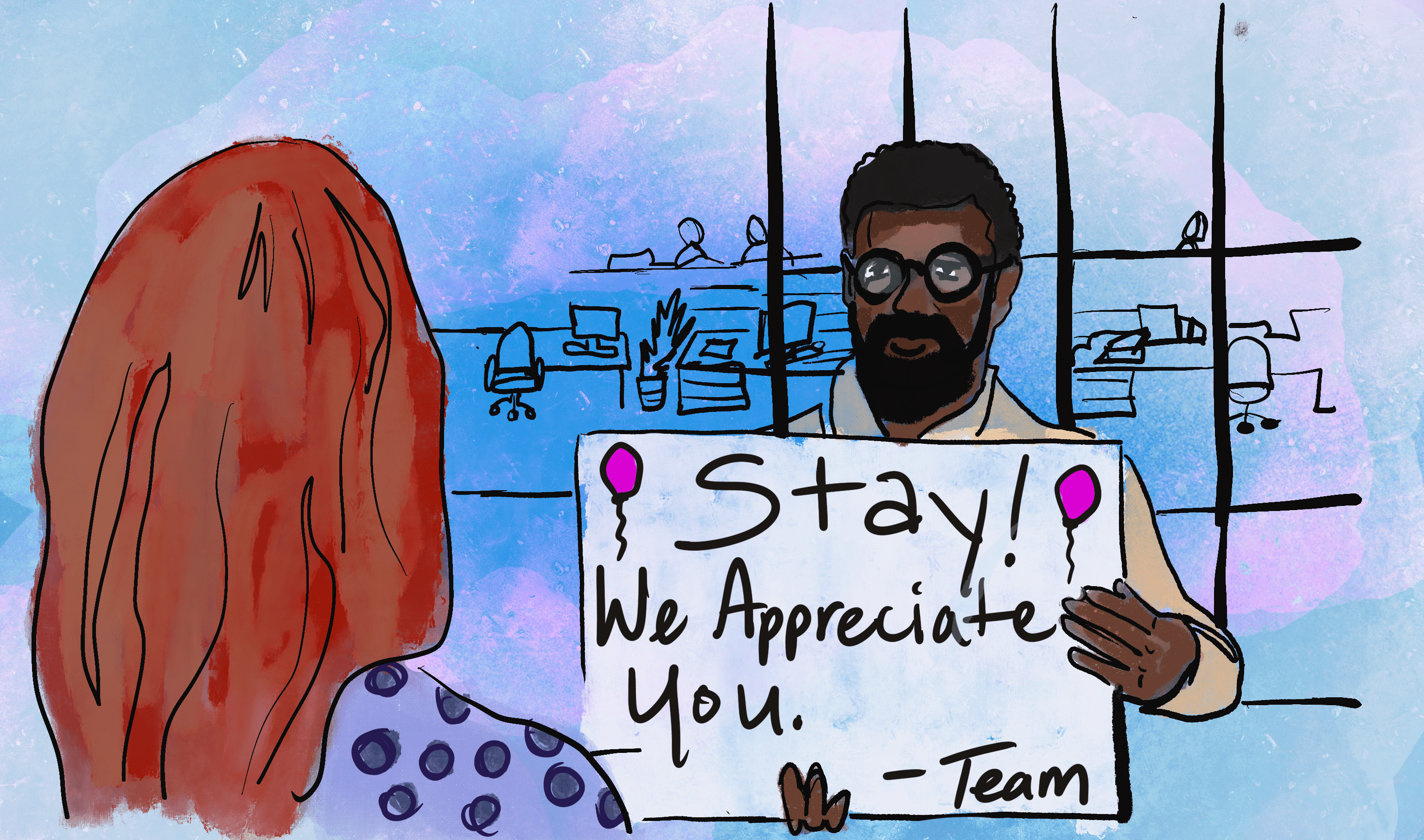As part of a talent retention strategy, some companies use “stay interviews,” or one-on-one meetings with employees to discuss what works for the individual and what can improve to encourage them to stay. While this process has typically been for high performers, companies are recently applying this effort more broadly to improve retention in a volatile talent market.
“We’re in a current moment of stay interviews kind of having this cultural awakening,” says Jim Conti, talent partner at Hyde Park Venture Partners. Companies are asking questions that are targeted, specific and the intention is to communicate with the person that “we want to retain you.”
Although this approach to talent retention is growing in popularity, how companies go about conducting and acting on stay interviews is important. “Think holistically about if you’re just doing this as a drop in the bucket, it is probably going to fall flat because, to some extent, people won’t see the continuation,” Conti says.

Continuous conversations as part of a healthy organization
While stay interviews can be helpful for talent retention, most experts agree ongoing communication is crucial to the health of an organization. Some sources even disagree with the practice.
“I don’t believe in stay interviews,” says Carolyn Rhodes, HR and DEI consultant and founder of Rhodes Consulting. Instead, “Companies need to develop ways of engaging conversations and having meetings prior to an employee leaving.”
She suggests hosting one-on-ones at least quarterly between managers and their direct reports, or monthly department-wide meetings to gather feedback and address the challenges employees face, well before they leave.
“Stay interviews seem short-term oriented,” says Matthew Painter, Ph.D., director of leadership development at UAB Medicine and founder and principal of Straitpath Solutions. Painter echoed that these conversations should be happening continuously, in the first place.
Ongoing conversations between managers and direct reports should include space for sharing dissatisfaction and how the organization can support growth and development. Then, bi-directional feedback loops enable managers to share that feedback to the right decision makers, Painter said.
Over time, these ongoing conversations reinforce a partnership to define and improve performance in the short and long-term, Painter said.
Jim Stroud, VP of marketing at Proactive Talent, says his organization uses a combination of open-door policies, regular check-ins, corporate retreats and surveys in its talent strategy, gathering feedback across the organization throughout the year.
Of course, leaders can’t cave to every frustration employees share, but they can come to a compromise. Stroud shared an example of how an employee expressed frustration about a client: Stroud’s team validated the employee’s frustrations, but also spelled out that this client’s project ultimately helps pay employees, and they shared a future plan for better choosing clients. Lastly, when the project completed, the leaders encouraged the worker to take a mental health day.
“A lot of times what these stay interviews prove or reveal, more than anything else, is that workers want to be heard,” Stroud said. “Even if nothing changes, even if they don’t get their way, if they feel that you’re listening and, if possible, change will be made, and if not, you’ll explain why, they’ll respect that. At least that has been our experience.”
How to conduct successful stay interviews:
- Be ready to receive feedback and act on it.
Before any interviews are scheduled, applicable parties such as HR and the C-suite should come together to discuss the purpose of the process, identify goals tied to stay interviews, and most importantly, understand that feedback is on its way.
“Commitment to getting the feedback and taking action is a mindset perspective that comes in before the process,” Conti says. “You’re not going to come out on the other side of a stay interview process finding out that you’re the best employer in the world.” Instead, organizations will gain an understanding of what they do well and what they can do to improve the employee experience.
- Identify interviewees.
While stay interviews have most popularly been a tool to retain high-potential employees, Conti says it is important to consider the rest of the employee population. While it might not be realistic to interview everyone on staff, especially at large organizations, leaders should consider the people left out of this process and their importance to the organization.
“I have not seen, nor experienced this perfect, magical formula” for whom to include, Conti says. But choosing who is part of the interviewed group should be intentional. He offered that leaders consider who the people are that will give the best feedback on what the organization can do to improve retention.
- Prepare your questions.
Questions should be targeted, specific and communicate to the interviewee, “we want to retain you,” Conti says.
When brainstorming these questions, consider what the organization wants feedback on. Conti says many of the questions should be open-ended and include ratings.
Ratings, such as a scale of one to 10, can help interviewers identify specific actions that will help with retention. “I don’t particularly care about the initial response,” he says. Instead, he likes to ask, “What does it look like to increase that score by one? What would that be for you?” Interviewees will likely give specific and actionable feedback that the company can achieve in the short term.
Questions shouldn’t lead the interviewee to certain answers, Conti says. “If you’re coming in with a strong opinion about what the solution is, that’s fine, but good research means that you’re letting the research participants guide you to that answer.”
- Help interviewees prepare.
Most importantly, employees should understand what will happen with what they share during the interview. When managers or HR begin to ask personal, specific questions, interviewees could think their answers might impact their employment negatively and “that can be a very scary situation,” Conti says.
The organization should also prep employees on the structure of the meeting and what to bring with them.
“The best chance of an employee affecting change inside their environment when talking to a manager, is to come not only with problems, but to bring solutions to the meeting,” says Stroud. He encourages managers to set the meeting with employees, letting them know that it is coming up and what to expect. Interviewees should prepare to share frustrations and, where possible, solutions.
Stroud says managers should say up front how the communication will be structured, when follow-up meetings will take place and how feedback will come under advisement.
- Listen, reflect, synthesize.
During the interview itself, Stroud says the interviewer should approach with a listening mindset and even hold off on responding right away. Instead, they should take a moment to think and validate that they’ve heard the interviewee and that concerns will be addressed.
“You’re not there to give a solution, you’re not there to counter-argue, you’re not there to say, ‘yeah, but.’ You’re just a sponge to soak it all in,” Stroud says.
Conti also encouraged reflection, as well as confirming what the interviewee said. Although this adds to the timeline of a stay interview process, it also ensures the organization is accurately understanding the challenge or issue at hand. Getting it wrong could be frustrating to the employee, but asking for confirmation provides space to correct the misinterpretation.
Synthesizing this feedback can also be an opportunity for the talent acquisition team to gather some messaging to potential hires, Conti says. Positive feedback can inform the employee value proposition, and the areas the company is improving upon can be addressed in the hiring process. “Then, the messages we’re delivering with candidates are very consistent to the experience being had by the team,” Conti says.
To take this a step further, questions from stay interviews can be revisited during exit interviews, as part of a process of regularly checking up on how the company acted on the feedback gathered.
- Act on the feedback.
Not every piece of feedback will need action. However, “you can’t ignore the input of your people,” Stroud says.
“That’s where I’ve seen the most failure in a program like this,” Conti says. The company will ask for feedback and leadership gets scared or does not know how to reply with action, where appropriate. “If you ask for feedback and take no action, that is a trust-breaking activity more so than a trust-building one,” he says. (Reference step one.)
Some of the issues staff brings up could be solved in the short-term and others might take a couple of years. Conti encourages including a mix of short-term and long-term action items, so employees can see changes across various points in time, further building trust.
- Continue the conversation.
To keep on track with longer-term changes, organizations should create action plans and a regular cadence of checking in with staff for follow-ups, ensuring employees feel the progression of change. Leadership should also report on the progress of those specific action items, sharing them with the whole organization.
A successful stay interview process will even open the door to further feedback and ideas. When employees feel heard and see action, trust grows, and Conti says they’ll be hungry to give more.
Stay interviews versus exit interviews
Conti likened stay interviews to exit interviews, as they both involve talking to employees who might be out the door. However, with exit interviews, employees have already decided they’re leaving, so the company is not likely to feel obligated to act on feedback.
“You get a lot of information when someone is stepping out the door, but if you’re not afraid to get that information then, why were you afraid to get it earlier in the process in order to prevent that departure from happening?” Conti asks.
Rhodes added that these interviews — stay, exit, or otherwise — need to involve some follow-up. Her experience with exit interviews, specifically, had no advocacy for change that happened after departure. Because the employee is leaving, the company doesn’t feel the need to act on their feedback, which leaves the employee feeling ignored and replaceable, even robotic, she says.
What’s the result of inaction? Employees feel their voice is not heard, Rhodes says. “They also believe that change will never happen.” Trust erodes and employees eventually become numb in their roles. Organizations will see less participation in surveys, fewer people joining team-building activities and a reduction in work effort.
“Companies have to understand how you make people feel, even if they’re leaving or they’re staying,” Rhodes says.
DEI impacts from stay interviews
Stay interviews can be useful in gathering feedback, including for diversity, equity and inclusion efforts — or it can further exacerbate the disparities minorities face when it comes to pay and representation.
Conti says stay interviews are an opportunity for gathering stories about what the organization does well and where it can improve. When interviewing new job candidates who ask about areas of improvement or the criticism they’ve seen on Glassdoor, the hiring manager can share those stories and be prepared to share how the organization is addressing the areas that need more attention.
“That consistency of message can be incredibly important, from a candidate perspective,” Conti says.
However, Rhodes sees stay interviews differently. “Stay interviews have almost been like a counter-offer for employees that are thinking of leaving,” she says.
If an organization is doing everything it can to retain certain employees, the adjustments made —around increasing salary, giving promotions, allowing for a more flexible work environment, etc. — often aren’t applied across the organization. “When companies do that, what they’re doing is valuing one employee over the other, so there’s not an equitable process,” Rhodes says.












